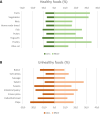Change in eating habits after 2 years of pandemic restrictions among adolescents living in a city in northern Italy: results of the COALESCENT Observational Study (Change amOng ItAlian adoLESCENTs)
- PMID: 38966110
- PMCID: PMC11221285
- DOI: 10.1136/bmjnph-2023-000817
Change in eating habits after 2 years of pandemic restrictions among adolescents living in a city in northern Italy: results of the COALESCENT Observational Study (Change amOng ItAlian adoLESCENTs)
Abstract
Background: Lockdown measures during the recent pandemic, due to the novel COVID-19, affected several other aspects of lifestyle, but little is known about their long-term impact, especially among adolescents. Our study aimed to assess the long-term consequences of changes in diet, exercise and screen activity levels, sleep quality, smoke, smartphone addiction and emotional distress among a sample of Italian adolescents, 2 years after the beginning of the pandemic.
Methods: We submitted an online survey to high-school students in the province of Brescia, a city in Northern Italy, investigating changes in food consumption and in physical and screen activities, cooking skills, sleep duration and quality, emotional distress, smartphone addiction and nutrition knowledge. We assigned an Eating Habit Index (EHI) score from 0 to 54, reflecting a current worsening (lower score) or improvement (higher score) in overall diet quality, compared with the pre-pandemic period. The χ2 test or Fisher's exact probability test and Mann-Whitney test were used as appropriate; a binary logistic regression model was carried out, with EHI score≥33 as the dependent variable.
Results: We collected 1686 questionnaires. Consumption of healthy foods increased, as it was for ultraprocessed foods (UPFs). EHI score>33 (75° percentile value) was associated with female gender (OR 1.81, p<0.0001), better nutrition knowledge (OR 1.54, p=0.001), better cooking skills (OR 1.43, p=0.01), lower consumption of UPFs before the pandemic (OR 2.19, p<0.0001), self-perception of healthier diet quality (OR: 4.05, p<0.0001) and no smartphone addiction (OR: 1.35, p=0.02).
Conclusions: Considering the profound impact of lifestyle on both physical and mental health, our results could be relevant to understand how to promote healthy eating practices among young people.
Keywords: COVID-19; Dietary patterns.
© Author(s) (or their employer(s)) 2024. Re-use permitted under CC BY-NC. No commercial re-use. See rights and permissions. Published by BMJ.
Conflict of interest statement
Competing interests: None declared.
Figures



References
-
- World Health Organization . Novel Coronavirus (2019-nCoV): strategic preparedness and response plan: draft as of 3 February 2020. Available: https://www.who.int/docs/default-source/coronaviruse/srp-04022020.pdf [Accessed 06 Jun 2023].
-
- The Italian Prime Minister . Law decree February 23rd 2020. Available: https://www.gazzettaufficiale.it/eli/id/2020/03/08/20A01522/sg [Accessed 05 Oct 2023].
LinkOut - more resources
Full Text Sources
